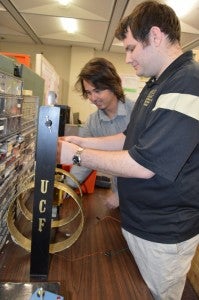For more than 10 years, scientists and engineers have been developing satellites the size of softballs that float in space and collect data, such as weather conditions.
These picosatellites, which weigh less than 1 kilogram (about 2.2 pounds), are a lot less expensive than conventional large satellites and easier to launch into space as secondary payloads because they take up so little room on spacecraft.
But there’s one problem – many payloads require that the picosatellite point in a specific direction. That’s where a partnership between a planetary sciences researcher and an engineering associate professor at the University of Central Florida comes in.
Todd Bradley and Yunjun Xu went to grad school together and have stayed friends throughout their careers. They both have common interests in pico-scale satellite technologies and their applications in space science. When they both got jobs at UCF, they naturally started talking about their work. Soon a joint project evolved.
They wanted to test how well a picosatellite (more commonly known as CubeSat) can point a payload in zero gravity by using the Earth’s magnetic field.
“It’s just amazing how quickly the technology is moving,” said Nicolas Pelaez, one of two aerospace engineering students who worked on the project. “Everything is now getting smaller, so hopefully soon we’ll be able to do a lot more with picosatellites in space.”
The current team, including fellow student Chris Stevens, worked on the project for a year. They made significant modifications to a 10x10x10 cm satellite (about 4 inches cubed) and then suspended it in air on a string. Two Helmholtz coils on opposite sides of the cube produced magnetic fields to mimic the Earth’s own field. They tested and adjusted, tested and adjusted and then tested and adjusted again until they had a working model. The NASA Florida Space Grant Consortium has provided support since 2009 when an engineering senior design team first began working on this project.
In February Bradley, Pelaez and Stevens got to ride a Zero-G plane – courtesy of NASA in Houston – for four days to test whether their control system worked. They experienced zero gravity 160 times during their flights to see if what worked in the lab, worked on the plane. Click here to see a video of the experience.
“It did, I can say it was successful,” said Bradley, who leads the zero-gravity experiments for the team. “We’re still combing through all the data we collected, but it worked just as we expected it would.”
When the plane hit zero gravity, the picosatellite free-floated. The team was able to instruct it to turn in specific directions and it oriented itself accordingly each time using the earth’s magnetic field. The experiments served as a flying laboratory to test the performance of the satellite because in the ground lab the satellite can only rotate around one axis.
The next step, Xu said is to hopefully obtain enough funding and find a flight opportunity to send it into a low Earth orbit.”
Pelaez will likely already have graduated by the time their satellite is launched, but he said the experience was priceless.
“I learned an insane amount during this project, with the two main areas of focus being simulations and software coding,” Pelaez said. “This experience has given me huge insight into how a real professionally run experiment should be conducted.”
He plans to eventually start his own space-related engineering business.
Bradley, who’s worked on several space missions including Messenger (orbiting Mercury), Cassini (studying the Saturn system), and OSIRIS-REx (an asteroid sample return mission), is optimistic that soon the technology will reach the point where the picosatellites will be able to carry more sophisticated science experiments.
As a member of UCF’s Center for Microgravity Research, he’s working on developing a scientific instrument that would study the dust particles found orbiting Earth. The device is small enough that it could be attached to a picosatellite and would collect dust data he needs. It could yield clues about how the planet was formed millions of years ago. The Space Research Initiative, through the Florida Space Institute, is funding research and development of the dust instrument.
“I think working together, collaboration between scientists and engineers can get us there,” Bradley said. “I really think that’s the best approach.”

